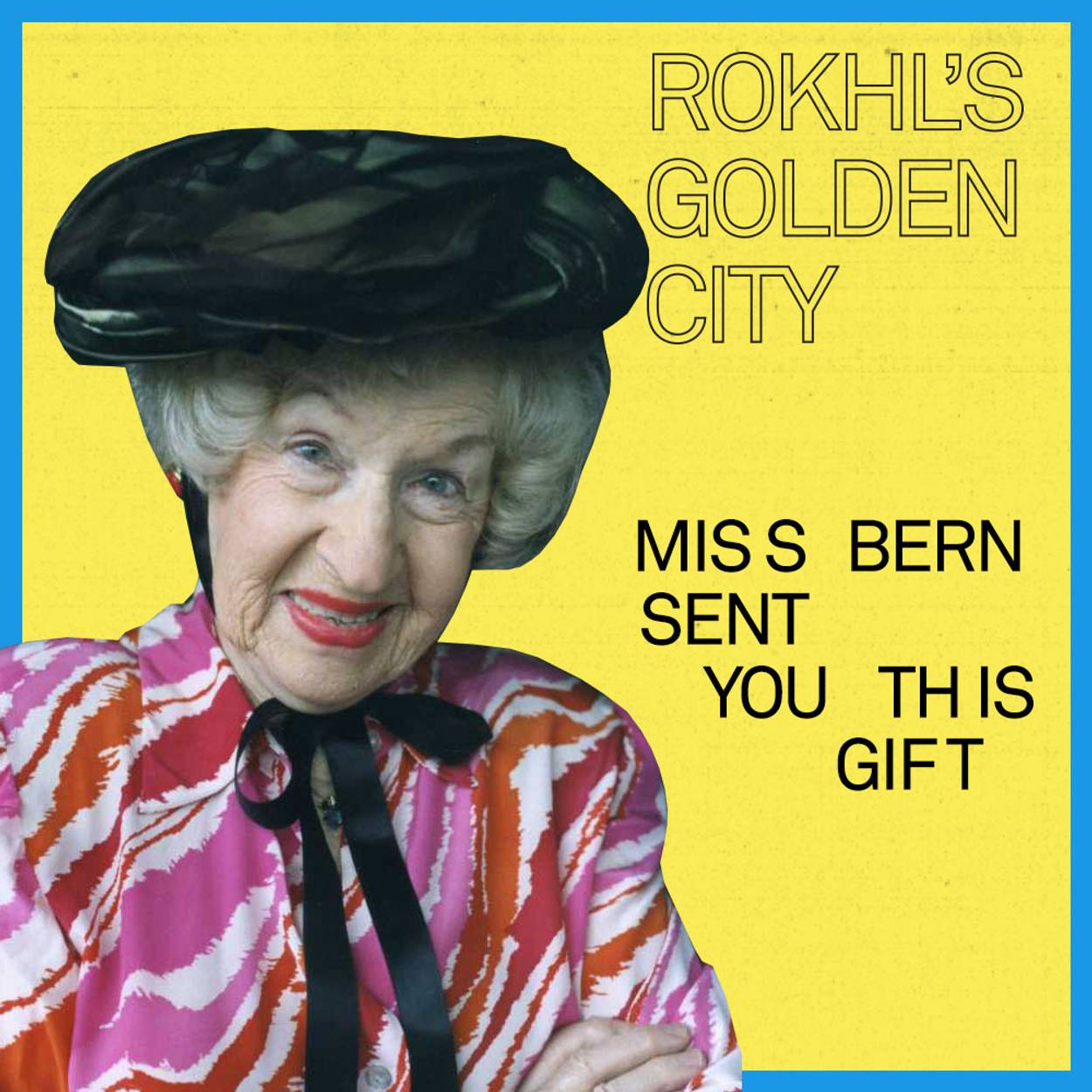Yiddish in Israel
Rokhl’s Golden City: How a brawl in Tel Aviv changed the theater scene in New York, and why Israeli soldiers are speaking Yiddish to fight COVID-19




Most of us take as common wisdom that Israel’s impact on Yiddish theater was negligible, with the state’s role being mostly as persecutor of Yiddish, language and culture. But in fact, the New York Yiddish theater scene owes much to a scandal that took place in Israel—the story of a butcher, his brass knuckles, and a fateful Tel Aviv night.
In 1947, Haaretz drama critic Haim Gamzu was leaving a Tel Aviv cafe popular with artists. On the street he was met by the aforementioned butcher, Janusz Alter Rapaport. Rapaport beat Gamzu so severely he was laid up in the hospital for over two weeks.
What could have provoked such a vicious attack? Gamzu had recently given a less than laudatory review to a cabaret performance by Mina Bern. This enraged Rapaport, who fell on Gamzu, shouting, “You had this coming! Miss Bern sent you this gift in return for your review.” No doubt in large part due to l’affaire Gamzu, Bern left Israel and in 1949 she settled in New York. There, she reinvigorated the New York Yiddish scene. With her husband, Ben Bonus, she ran the Village Theater on Second Avenue, a showcase for Yiddish performance. At the end of the 20th century she was one of the last of the grandes dames of the Yiddish theater and she was the first genuine Yiddish theater legend I met (at the Folksbiene office, in 1998).
I mention Bern because this March marked her 10th yortsayt. The Congress for Jewish Culture, in partnership with YIVO, had planned an evening in her honor. Due to ongoing events in New York, the event, like much of the social life in New York this spring, had to be pushed off indefinitely. Bern was a formative influence on Congress for Jewish Culture director Shane Baker, who met her in the mid 1990s.
It’s interesting to contemplate what might have happened to Bern’s career had Rapaport not taken matters into his own hands (and knuckles). Though she started her career in Palestine on the Yiddish stage, she quickly mastered Hebrew and was a featured player in the Hebrew cabaret scene in Tel Aviv. Had Rapaport been slightly less passionate about her, Bern might have spent the rest of her life in Israel, on the Hebrew stage, perhaps occasionally performing a Yiddish song, for old times’ sake.
But it’s not quite accurate to say that Bern would have been forced to choose Hebrew over Yiddish. In her provocative new book Yiddish in Israel: A History, historian Rachel Rojanski says that though the majority of post-1948 Yiddish speaking immigrants to Israel did not choose to come for ideological reasons, they still “identified with the state” and “not only accepted Hebrew as the language of the Jewish nation state but also chose not to pass on their own language, Yiddish.”
Rather than relying on legislative coercion to force Hebrew on new citizens, the state enlisted “soldiers of hegemony,” volunteer Hebrew teachers who turned the ideological goal of Hebrew literacy into a collective project, willingly undertaken.
Rojanski argues that the position of Yiddish in Israel is far more complicated than a unidirectional, oppressor/oppressed binary. As she demonstrates, the state never had a cohesive policy toward Yiddish and other “foreign languages.” Its relationship with Yiddish and Yiddish speakers is better understood as a set of dialectical tensions “between diverse and sometimes contradictory impulses.” And it was in between those varying impulses that Yiddish culture continued to thrive, at least through the mid-1960s. (See my column on the tremendous body of work created by multilingual poet/translator/songwriter Moshe Sachar during this period.)
Mapai (the predecessor to the modern Labor Party) advocated a strong, pro-Hebrew ideology. But it also needed to cultivate public support among the huge and diverse new immigrant population. Mapai leaders saw the Yiddish speaking demographic—literate, sophisticated, and politically active—as key to their success. This led to Mapai becoming what Rojanski calls an actor “in the Yiddish speaking space,” at times even publishing its own Yiddish newspaper and supporting Yiddish cultural activities.
Rather than suppressing the Yiddish press (which was often sharply critical of the government), Israel’s ruling party sought to influence Yiddish speaking immigrants in their own language. It’s the kind of paradoxical moment that recalls the early Eastern European maskilim. The maskilim realized that if they wanted to spread their Enlightenment ideas to the masses, they had to reach them in their own language, the previously reviled zhargon of Yiddish. That utilitarian impulse that led to the astonishing efflorescence of Yiddish literature in the 19th and 20th centuries.
The question of Yiddish theater in Israel is also complicated. At times the government created obstacles to the staging of Yiddish theater. At other times, the government, and the press, supported the Yiddish theater, especially theater perceived to belong to the realm of high art. In 1953, actor and Yiddish theater impresario Joseph Buloff made his first of many visits to Israel. The visit was a smashing success and the Israeli press was unstinting in its praise of Buloff, as well as emphatic in their view of the importance of his presence in Israel. Rojanski notes that by the mid-1950s, foreign performers who came to Israel to perform in Yiddish were regarded as having something valuable to add to the new state. “Above all,” writes Rojanski, “they were thought to help make Israel the center of Jewish culture worldwide.” Again, it’s important to pay attention to the reciprocal nature of the relationship between Yiddish and the Jewish state.
But by the mid-1960s, Rojanski argues, the window of memory and nostalgia for Eastern Europe had finally closed and Yiddish cultural activity experienced its final stage of marginalization. Perhaps if Yiddish had been the target of more rigorous, and explicit, legislative suppression, it might have come back as a resurgent minority identity, one that could serve as a countercultural touchstone. Instead, a lack of education about Yiddish and Eastern Europe fed into the reflexively anti-diaspora Zionist zeitgeist. My own experience with (non-Yiddishist) Israelis has found that even among those who are the most critical of the state and/or Zionism, the topic of Yiddish (and Eastern Europe) is almost invariably met with benign disgust, if not outright contempt. To paraphrase the American philosopher Meat Loaf, they’re willing to criticize almost any aspect of Israeli life, but they won’t criticize that.
Relations between the Israeli state and its Yiddish-speaking Haredi enclaves have never been great, but this spring’s pandemic has mutually exacerbated frayed nerves. I woke up recently to numerous friends in Israel drawing my attention to a Yiddish-language cheat sheet given to soldiers deployed to control movement among the residents of Bnei Brak.
The list’s polite phrases like “I don’t feel good” and “please help me” struck me as sadly insufficient for the soldiers’ task. Not to mention that the academic Yiddish used for the transliteration would no doubt strike the actual Yiddish speakers of Bnei Brak as incongruous.
In 1997, Michael Chabon discovered the Say It in Yiddish guidebook, a midcentury artifact that spoke to him of a world that had both vanished and yet never existed. His mind boggled at the thought that someone in 1958 might have needed the Yiddish equivalent of “What is the flight number?” or “I need something for a tourniquet.” Chabon’s encounter with his otherworldly madeleine eventually led to the comic fantasy of The Yiddish Policemen’s Union and the what if of a Yiddish-speaking region in Alaska.
Yet here we are, in 2020, and among our current bumper crop of tragedy and pathos, we find Israeli soldiers tasked with communicating with the residents of Bnei Brak, a population hard hit by COVID-19. The soldiers would be far better off with something like Say It in Yiddish, but are instead equipped with the equivalent of a Post-it note and a prayer. It would almost be funny if there weren’t so many lives at stake.
What’s really ironic, though, is that the gulf between the modern Hebrew-speaking soldiers and the Yiddish speakers of Bnei Brak is not quite as wide as it would seem. As the government cheat sheet tells us, the Hebrew ma nishmah (how are you?) translates to the Yiddish vos hert zikh. It is a quite literal translation—Yiddish was transformed into Hebrew by its revivalists. At least, that’s the thrust of the other most important book about Yiddish in Israel to come out in 2020, linguist Ghil’ad Zuckermann’s new book, Revivalistics: From the Genesis of Israeli to Language Reclamation in Australia and Beyond. Solidly aimed at an audience comfortable with linguistic theory, Revivalistics also offers much to anyone interested in the question of language revival, as well as modern Hebrew and Yiddish.
Zuckermann is a polyglot polymath and Revivalistics is an ambitious volume. Part of the book lays out his theory of modern Hebrew, or what he calls “Israeli.” This is to make explicit his belief that rather than being a continuation of ancient and mishnaic Hebrew, Israeli is a non-Semitic, totally new language, one whose intrinsic character reflects the mother tongues of its creators.
There’s far more to the book than I can cover here. But one of the most interesting aspects is how Zuckermann explores (and conceptualizes) the Yiddish substrata of “Israeli.” Not just Yiddish words that have been brought into the language, but the innumerable direct translations (calques) from Yiddish to “Israeli” as well as carried over linguistic forms. Zuckermann is an irrepressible punster, which makes reading him both very fun and very challenging. He echoes Rachel Rojanski when he writes, “Israeli is not רצח יידיש rétsakh yídish (Israeli for “the murder of Yiddish [by Hebrew]”) but rather יידיש רעדט זיך yídish rédt zikh (Yiddish for “Yiddish speaks itself [beneath Israeli]”). It’s a surprising but welcome theme for a confusing, scary time.
MORE: Ghil’ad Zuckermann’s new book Revivalistics: From the Genesis of Israeli to Language Reclamation in Australia and Beyond was supposed to have a New York launch party but that’s been tabled for the forseeable future. You can still buy the book, here, 30% discount promo code: AAFLYG6 … Rachel Rojanksi’s Yiddish in Israel: A History is available here. At the beginning of April she gave a seminar at the Schusterman Center for Israel Studies at Brandeis, for which video should be up very soon.
ALSO: Monday, April 13, the Congress for Jewish Culture, in partnership with the Workers Circle, will carry on its tradition of hosting a Yiddish Third Seder. This year will be its first online, participatory Seder. Reserve a place here … From April 11 to May 3 the Medem Bibliotheque in Paris will be offering virtual Yiddish literature seminars including one on Peretz and the fifth cholera epidemic … You can now stream a filmed live performance of The Thomashevskys: “conductor Michael Tilson Thomas explores the lives of his grandparents Boris and Bessie Thomashefsky, founders of America’s Yiddish Theatre, through a musical performance with Eastern European klezmer and the New World Symphony orchestra.” … Tkhines are Yiddish language prayers, usually composed by and for women. Over at the Open Siddur project a number of folks have collaborated to bring you a 1916 prayer, “Tkhine When an Epidemic Breaks Out,” in Yiddish with English translation… The most excellent folks of Vaybertaytsh are holding weekly Yiddish language conversation sessions, via Zoom… From my friend Itzik Gottesman, a delightful recording of his brother singing the Four Questions in Yiddish… and if you’re looking for a Yiddish-language Haggadah, consider using this American Haggadah from 1948.
Rokhl Kafrissen is a New York-based cultural critic and playwright.